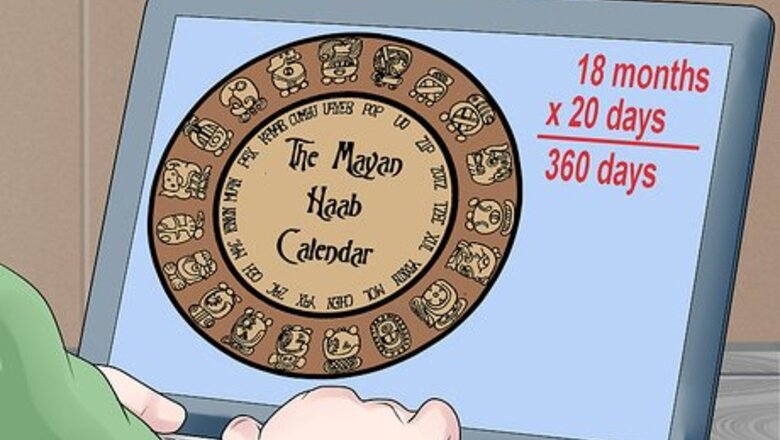
views
X
Research source
) calendar received a great deal of publicity as the year 2012 drew to a close, resulting from claims that it predicted the world would end on December 21 of that year. However, the Maya calendar called for only an end to that particular calendar cycle and the start of a new one. The full Maya calendar is complex and composed of a number of different cycles that interlock and repeat. By understanding the elements of these cycles and how they work together, you can learn to read the Maya calendar and compare it to the widespread Gregorian calendar.
Using the Haab, Tzolkin, and Long Calendars
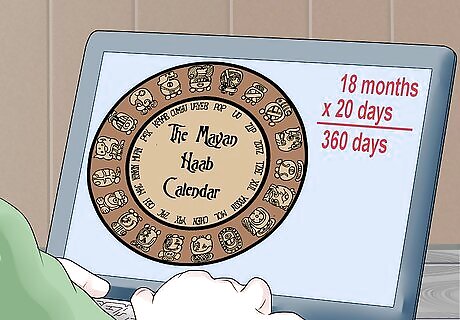
Learn the divisions of the Haab calendar. The Haab calendar is one Maya method of counting time. It is roughly based on the solar cycle, and so it is relatively recognizable to users of the Gregorian calendar. “Haab” itself translates as “year.” Each haab has 18 months (uinals) of 20 days. This makes a Haab of 360 days, or one tun. In addition, each haab has one month of 5 days (Wayeb). Together, this makes 365, which approximates the solar year (365 ¼ days). A tun is also called a vague year, since it only approximates the solar year—it does not include the ¼ day or a leap day every four years, like the Gregorian calendar does.

Count using the months of the Haab calendar. Each 20-day uinal and the 5-day month Wayeb are counted beginning with day 0 and ending with day 19 or 4, respectively. The 19 months of the Haab calendar, in order, are: Pop Wo Sip Sotz Sak Xul Yaxkin Mol Chen Yax Sak Keh Mak Kankin Muwan Pax Kayab Kumku Wayeb
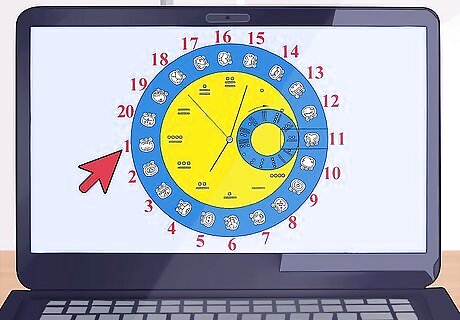
Count using the Tzolkin calendar. The Tzolkin calendar has 20 days. These days cycle 13 times in a Tzolkin year, which differs from a Haab calendar year. Each day for each cycle has an attached number running 1-13. This makes for a total year length of 260 days. Scholars do not know why the cycle is 260 days. Some believe this length is related to agricultural cycles, others to the movement of heavenly bodies (such as the planet Venus), and others to the human gestational period.
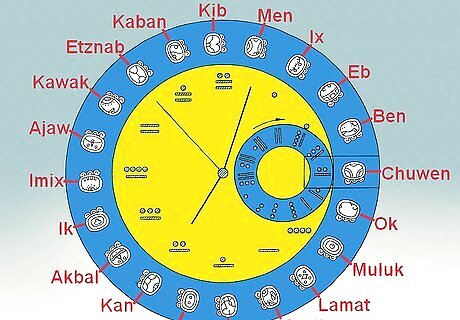
Reckon using the days of the Tzolkin calendar. Each day in the Tzolkin cycle has a sacred significance (honoring a particular god, for instance), and a unique name. The days are (in order): Imix Ik Akbal Kan Chicchan Kimi Manik Lamat Muluk Ok Chuwen Eb Ben Ix Men Kib Caban Etznab Kawak Ajaw
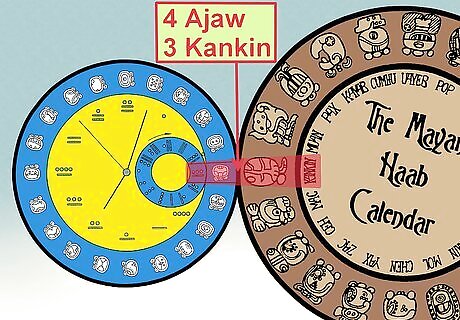
Put the Haab and Tzolkin Calendars together to make a whole date or calendar round. Most Maya dates are expressed as a combination of the Haab and Tzolkin calendars. The two form an interlocking system known as a calendar round, forming long cycles between repetitions of each date. The complete calendar round contains 52 repetitions of 365 days (18,980 days). This creates combination dates such as 4 Ajaw 3 Kankin and 7 Manik 10 Kankin.
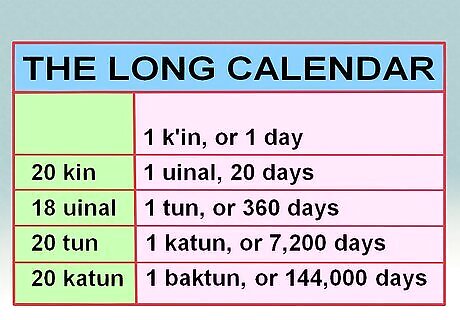
Use the Long Calendar for greater spans of time. The Maya calendar also has larger cycles for reckoning spans of time that are longer than 52 years. The specific name of this calendar is not known, so archaeologists refer it to simply as the “Long Calendar.” This calendar has a cycle totaling 5125 1/3 years. The Long Calendar represents five cycles of time, similar to how the Gregorian calendar represents days, months, years, centuries, and millennia. The five cycles are: Kin, or days Uinal (each uinal is equivalent to 20 kin/days) Tun (each tun is equivalent to 18 uinal, or 360 days) Katun (each katun is equivalent to 20 tun or 7200 days) Baktun (each baktun is equivalent to 20 katun, or 144,000 days)
Putting it All Together
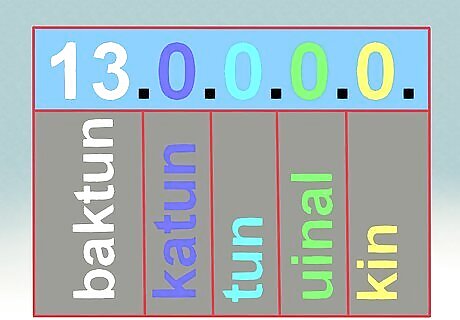
Read the Maya long count date. The Maya calendar reckons any date in terms of its distance from a fixed start date. For the Maya calendar, this fixed date represents the start of a Maya creation cycle. Archaeologists write this start date as 13.0.0.0.0. Each number (separated by a dot) in the expression 13.0.0.0.0 represents a position within the five cycles of the Long Calendar, in the order baktun, katun, tun, uinal, kin. The Maya creation cycle repeats, with each cycle beginning with the start date 13.0.0.0.0. It is unknown why the cycle begins with 13 baktun rather than 0.
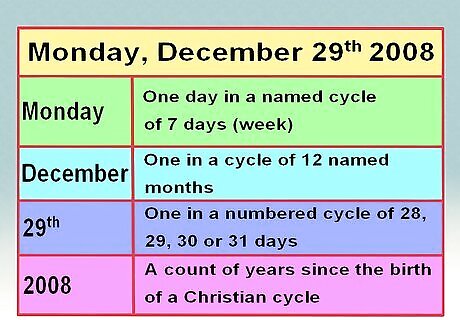
Understand how dates are recorded and read using the Gregorian calendar. Used in much of the contemporary world, the Gregorian calendar provides a familiar method for marking time. Take the date Monday, December 29th, 2008, for example: “Monday” signifies one of a cycle of 7 days forming a week. The date (29, in this example), signifies a particular position within the unit of one month, which may be 28, 29, 30, or 31 days in length. The year (2008) signifies a certain number of years since a fixed reference point (the traditional birth of Christ at the year 0).
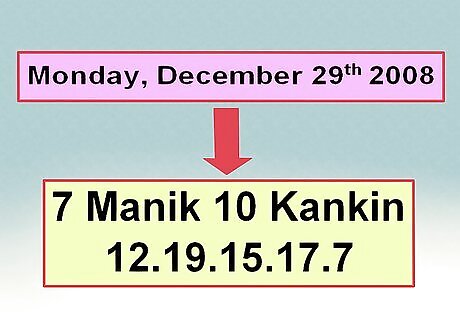
Compare this familiar system to the same date written using the Maya calendar. “Monday, December 29th, 2008” would translate to “7 Manik 10 Kankin 12.19.15.17.7” when written according to the Maya calendar. The elements of this date are: Manik signifies the day within a named cycle of 20 days used in the Tzolkin calendar. The 7 following signifies the date's position within a cycle of 13 days used in the Tzolkin calendar. Kankin provides the name of one in a cycle of 18 months used in the Haab calendar. 10 gives the date's position within a cycle of 20 days forming one uinal, or month. 12.19.15.17.7 provides the number of years since a fixed reference point, the start of a Maya cycle: 12 baktun, 19 katun, 15 tun, 15 uinal, 7 kin.
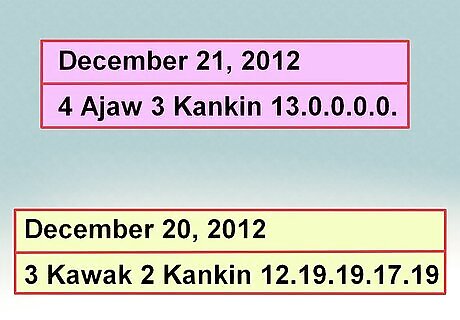
Express the Maya creation cycle date. The current Maya creation cycle’s start date of 13.0.0.0.0 corresponds to the date December 21, 2012 in the Gregorian calendar. The start date of the previous cycle (which ended on December 20, 2012), 13.0.0.0.0, corresponds to the date August 11 (or 13) 3114 BC/BCE in the Gregorian calendar. December 21, 2012, which came after the end of a long cycle in the Maya calendar, would be written as 4 Ajaw 3 Kankin 13.0.0.0.0 using the full calendar expression. Similarly, the previous day, December 20, 2012, would have been written as 3 Kawak 2 Kankin 12.19.19.17.19

Use a calendar converter. There are several online tools for converting dates in the Gregorian calendar to the Maya calendar. These tools allow you to reference the Maya calendar quickly and easily, without doing complicated calculations or using charts.




















Comments
0 comment